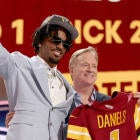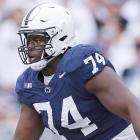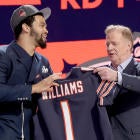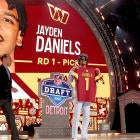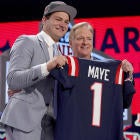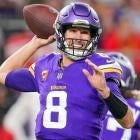Expectations for the Raiders are at a level they haven't been since the early 2000s, because general manager Reggie McKenzie's arduous rebuilding process culminated with the end of a 14-year playoff drought in 2016.
The Raiders living up to their slogan of "Commitment to Excellence" was spurred by impact free-agent signings and a stellar 2014 draft class in which edge rusher Khalil Mack, quarterback Derek Carr and guard Gabe Jackson were selected in the first three rounds. Although playoff success eluded the Raiders with their Pro Bowl quarterback sidelined by a broken right fibula, the 12 regular-season wins in 2016 were the team's most since 2000. Oakland heads into the 2017 season as arguably the biggest threat in the AFC to dethrone the reigning Super Bowl champion New England Patriots.
But just as the Raiders' championship window opens, the equation is changing. Mack, Carr and Jackson are eligible for contract extensions. How big of a window the Raiders have will depend on McKenzie's ability to navigate potential pitfalls while building a roster when this talented trio is no longer on rookie contracts.
The high price of successful drafting
Getting Carr under contract long term is McKenzie's main offseason focus now that the NFL Draft has taken place. The 2014 second-round pick is a higher signing priority than Mack because he is entering his contract year. Mack's contract year is 2018 since first-round picks are subject to a fifth-year option, which the Raiders exercised for $13.846 million.
Carr recently shot down reports that he was frustrated with the pace of negotiations. He indicated he has complete faith that his new deal will be in place before training camp starts in late July. Nonetheless, Carr set a deadline for reaching an agreement. He will end his negotiations and play out his rookie contract, which pays him $1,152,519 in 2017, once training camp starts.
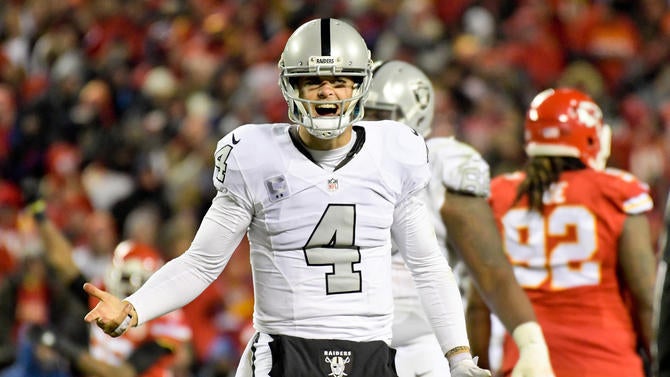
Carr could become the NFL's first $25 million player, eclipsing the five-year, $122.97 million extension Andrew Luck received last offseason from the Colts, after an MVP-caliber 2016 campaign. Luck reset the NFL pay scale with a deal that averages $24.594 million and contains $87 million in guarantees, of which $47 million was fully guaranteed at signing.
Carr putting a clock on negotiations was a smart move. The Raiders allowing Carr to play out his contract and the franchise tag game could be more costly, especially if he can duplicate or better his 2016 performance. It will be upwards of $24 million to place a franchise tag on Carr in 2018 whether using the exclusive or non-exclusive version. A Matthew Stafford extension making him the NFL's highest-paid player is a distinct possibility before the season starts.
The top of the quarterback market could have a dramatic shift in 2018. Aaron Rodgers is expected to sign a new deal with the Packers when there are two years left on his current contract. The Falcons will likely extend reigning NFL MVP Matt Ryan's contract next year as well since he will be in a contract year.
Mack has been everything the Raiders could have hoped for and more. He became the first player in NFL history to earn first-team All-Pro honors at two different positions during the same season (defensive end and outside linebacker) in 2015. Mack followed up this outstanding campaign by being named the NFL's Defensive Player of the Year last season.
A new deal will likely make Mack the NFL's first $20 million non-quarterback. That is, if Rams defensive lineman Aaron Donald, a fellow 2014 first-round pick, doesn't beat him to it. Negotiations between the Rams and Donald are ongoing. A Donald extension should serve as a salary floor for Mack.
The overall guarantees in Mack's deal could approach $75 million. The current benchmark for non-quarterbacks is the $70 million Von Miller received in the six-year deal averaging $19,083,333 he signed last summer as the Broncos' franchise player. The deal also made Miller the league's highest-paid non-quarterback.
There might be more urgency to extend Jackson before Mack. As a 2014 third-round pick, Jackson is also in a contract year. He made a successful transition from right guard to left guard in 2016 to accommodate free-agent signee Kelechi Osemele, who Oakland made the NFL's highest-paid guard with a five-year, $58.5 million deal (worth up to $60 million through incentives) containing $25.4 million fully guaranteed.
The Raiders will become one of the rare NFL teams with a heavy financial investment in guards thanks to an explosion of salaries in free agency this year. Kevin Zeitler established a new salary benchmark when he signed a five-year, $60 million contract containing $31.5 million of guarantees with the Browns. Ronald Leary received a four-year, $36 million deal from the Broncos with $24 million of guarantees after filling in for the Cowboys at left guard because La'el Collins was sidelined most of last season due to a foot injury. The Browns also extended 2014 second-round pick Joel Bitonio's contract five years at $10 million per year despite him missing 17 games over the past two seasons because of injury. His deal has $23,664,777 of guarantees.
A contract at $9 million to $10 million per year with over $20 million in guarantees, which is the going rate of the second salary tier for guards, might be necessary to keep Jackson. The Raiders would join the Browns as the only team with a pair of guards having contracts averaging at least $8 million per year.
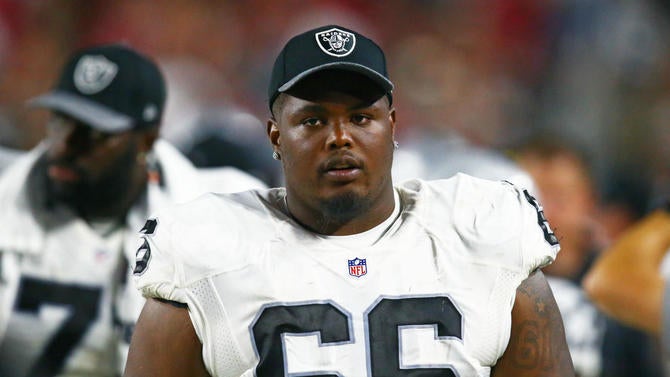
Using a franchise tag on Jackson, provided Carr is under contract long term, would be out of the question. It would be too cost prohibitive. The current offensive lineman number is $14.271 million, which is significantly higher than Jackson's value.
The Raiders are facing an unprecedented situation because of Carr and Mack's success. It is rare for teams to have a quarterback on a lucrative contract while also having one of the league's highest-paid non-quarterbacks. The Raiders are likely to become the first team in league history with a $20 million non-quarterback and a $25 million quarterback.
Among the highest-paid non-quarterbacks by average yearly salary, which in order are Miller (Broncos), Ndamukong Suh (Dolphins), Muhammad Wilkerson (Jets), Fletcher Cox (Eagles), Olivier Vernon (Giants) and Antonio Brown (Steelers), only the Giants (Eli Manning) and Steelers (Ben Roethlisberger) have quarterbacks making at least $20 million per year. Neither quarterback is among the five highest-paid at the position. The Rams will be on the other end of the spectrum as the Giants and Steelers once Donald joins the ranks of highly paid non-quarterbacks because their quarterback, Jared Goff, is entering the second year of his rookie contract.
It's a good problem when arguably the NFL's best young quarterback and a transcendent young defensive player are on a team's roster for the foreseeable future. Other NFL teams aren't going to have any sympathy for the impact Carr and Mack's massive deals will have on Oakland's salary cap.
McKenzie also struck gold in the 2015 draft with fourth overall pick Amari Cooper. The wide receiver has cracked the 1,000-yard mark in both of his NFL seasons. The Raiders will surely exercise Cooper's fifth-year option for 2019 next offseason, barring an unforeseen circumstance this season. His option year salary will likely be over $14 million.
Cooper could be in position to command top wide receiver money on his next contract if he continues to develop. By the time Cooper's contract is ready to be extended, Odell Beckham Jr. might have taken wide receiver salaries to another level on a deal averaging in excess of $17 million with more than $50 million in guarantees.
The 'pay as you go' contract structure
McKenzie has adopted an approach with practically all veteran signings that isn't embraced by most NFL teams. These contracts utilize a "pay as you go" structure. A player's cash and salary cap numbers are the same in each contract year because he is receiving salary guarantees instead of a signing bonus under the "pay as you go" model.
The first contract year usually consists of a fully guaranteed base salary and a roster bonus due a few days after signing. The most lucrative deals have salary guarantees in the second contract year as well. Since there isn't any signing bonus proration, the Raiders won't have any dead money, which is a salary cap charge for a player no longer on the roster, if a player is released during the latter part of a deal provided there hasn't been a restructure for cap purposes.
Contracts with this structure have higher cap numbers initially because of the absence of a signing bonus. Rodney Hudson's five-year, $44.5 million contract, which briefly made him the NFL's highest-paid center in 2015, is a perfect example of this concept. The cap number on the first year of his deal was $13 million. It dropped to $7.7 million in 2016 and $6.85 million in 2017 before rising again to $8.35 million and $8.6 million in the final two years. Hudson can be let go at any point after the 2016 season with impunity because the final three years don't contain any guaranteed money.
The Jaguars and Buccaneers are the most frequent proponents of the "pay as you go" structure outside of the Raiders. The Buccaneers adopted the structure first during Mark Dominik's tenure as general manager. Jacksonville's biggest contracts now contain relatively modest signing bonuses.
It will be difficult for the Raiders to sign the trio to new deals in 2017 without deviating from McKenzie's preferred structure at least to some degree considering the Raiders should have slightly over $31 million of cap space remaining once their entire draft class is under contract. Taking signing bonus deferrals with other high-priced quarterback contracts into account, Carr's 2017 compensation realistically should increase by between $20 million and $30 million on an extension. Luck made $30 million in 2016 under his blockbuster extension; $14 million of his $32 million signing bonus was deferred until this past March. When Russell Wilson signed a new deal in 2015, he made $20.7 million in the first year; $11 million of his $31 million signing bonus wasn't payable until the following April. Even at the lower end of this range, a choice will have to be made between locking up Jackson and Mack this year.
It will likely require the players sacrificing the size of the raises received this year for all three to sign with extensions before the season gets underway. A case can be made that Mack should be the most accommodating since his contract doesn't expire after the season. Parting ways with right tackle Austin Howard would give the Raiders $5 million more to devote to extensions. Giving the players, particularly Carr, a modest signing bonus would provide more salary cap flexibility to take care of all three this year.
Something has to give
Some of the same challenges the Seahawks have faced in making the transition from a championship-caliber team having a low-paid quarterback to a Super Bowl contender with a high-paid one are likely to occur with the Raiders. Seattle had has to make some difficult choices on which players to retain, compromising roster depth with a premium placed on the coaching staff's ability to develop draft talent. It's also going to be a different phenomenon for the Raiders consistently picking at the back end of each draft round instead of near the top of rounds.
The 49ers can also serve as a cautionary tale for the Raiders. Oakland's Bay Area neighbor was set to make the same transition until quarterback Colin Kaepernick regressed, a few key players unexpectedly retired and head coach Jim Harbaugh exited after losing a power struggle with general manager Trent Baalke, whose draft failures have handicapped the 49ers.
The Raiders are built primarily with homegrown talent, with 41 of the 62 players (66.1 percent) on the roster last season either drafted or originally signed as undrafted free agents. Only 10 of the 22 starters were homegrown. This number isn't expected to change this year despite some roster turnover but will need to increase in the future.
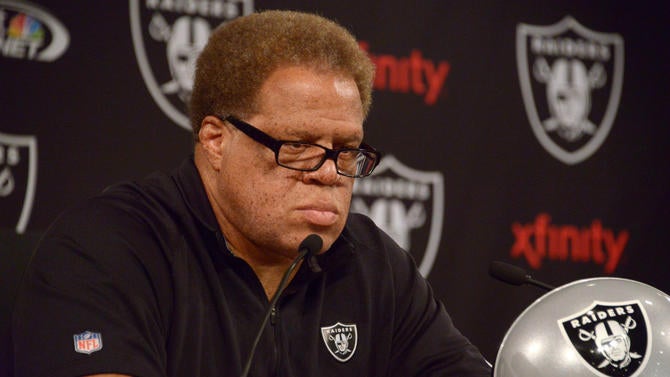
It will become vital for McKenzie to continue having successful drafts where more starters are homegrown because of Carr and Mack's upcoming deals. For example, cornerback Gareon Conley (2017 first-round pick), who is facing sexual assault allegations, and safety Obi Melifonwu (2017 second-round pick) quickly developing would allow the Raiders to make a seamless transition in the secondary next season. Safety Reggie Nelson, 33, is a free agent after the season. The Raiders could pick up $8.5 million of salary cap room from cutting Sean Smith, who turns 30 in July, next year provided Conley is cleared.
On the surface, it appears the Raiders have an abundance of salary cap space in 2018. There should be approximately $127.5 million of cap commitments for 2018 once the entire draft class is signed. The 2018 salary cap will be in the $180 million neighborhood if the growth rate from recent years continues. Up to $50 million of this space could be devoted to Mack, Carr and Jackson with new deals in place. There would also be very little cap space to carry over with all three re-signing this year.
Being extremely aggressive during the first wave of free agency as in 2015 and '16, when Bruce Irvin, Hudson, Osemele and Smith were signed, could largely become a thing of the past. It might become increasingly harder to sign players like Cordarelle Patterson to short-term deals in the $4 million to $5 million range as the salary paradigm shifts with the inclusion of more high-end contracts. However, the Raiders should be a favored destination for talented free agents once it becomes a buyer's market in the secondary phases of free agency. The move to Las Vegas in 2020 will help in this regard. Nevada is one of the few places, along with Florida, Tennessee, Texas and Washington, that doesn't have a state income tax.
Tough road ahead, but it can be done
Late last season McKenzie remarked, "We think we've built this thing to last." The Raiders could have an extended window of opportunity as Super Bowl contenders despite being on the verge of venturing into uncharted territory because of Carr and Mack's contracts.
The Raiders won't be in any danger of getting back into the massive cap problems that plagued them before McKenzie took over with new Carr and Mack deals because of their approach to structuring contracts. Once these deals are in place, the Raiders should have cap flexibility annually to retool the roster if necessary because of a lack of dead money.
As long as Carr stays healthy, and as long as talent is continually amassed through strong drafts so aging veterans and players that price themselves out of Oakland/Las Vegas or find better opportunities for playing time in free agency can be replaced cost effectively, the Raiders could become an NFL franchise to emulate.













